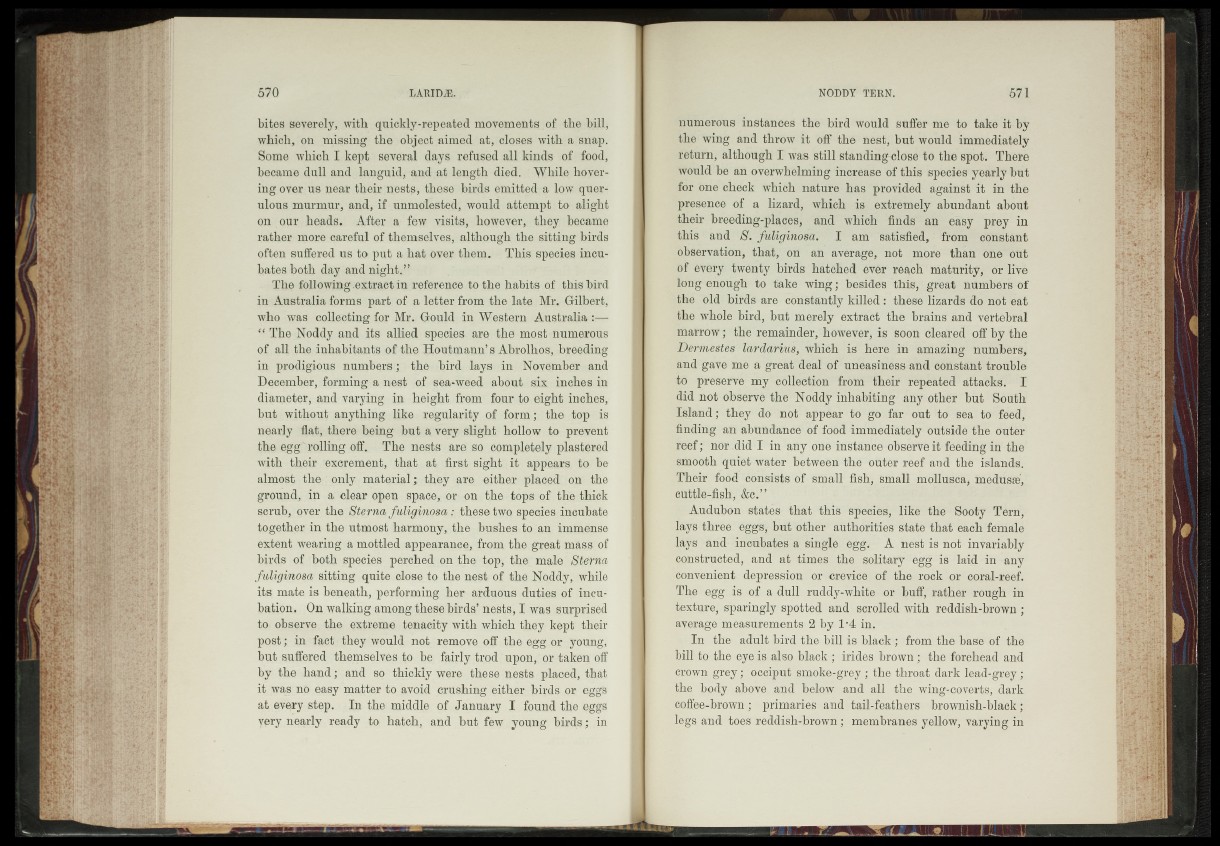
i R i l l
m m
Hl};: S
Iaafôlaji'ii j, S- re
l i a
g § |
bites severely, with quickly-repeated movements, of the bill j
which, on missing the object aimed at, closes with a snap.
Some which I kept several days refused all kinds of food,
became dull and languid, and at length died. "While hovering
over us pear their nests, these birds emitted-a low querulous
murmur, and, if unmdlbsted, would attempt to- alight
on opr heads. After a few visits, however, they became
rather more careful of themselves, although the sitting birds
often suffered us to put a hat Over them. - This species incubates
both day and night.”
The lollowing extract in reference to-the habits o.f this bird
in Australia forms part of a letter from the late Mr. filb e rt,
who was collecting for Mr. Gould in Western Australia*^
“ The Noddy and its allied species are the most-numerous
of all the inhabitants ofthe Houtmann’s Abrolhes, breeding
in prodigious numbers; the bird lays- -ih^Toitember- and
December, forming a nest of sea‘Weed about six inches in
diameter, and varying in height from four to eight inehes,
but without anything like regularity of-form; the top is
nearly flat, there being but a very slight hollow- to prevent
the egg vrolling off., Th© nests are' sq>- completely plastered
with their- 'excrement, that at, first sightr? it appears to
almost t h e 1 only m a te ria lth e y are either placed lo.n the
ground, in a clear open .space,; or* on the fops of the thick
scrub, qver ih6 Sjefna.fuligin§sa,:^t}ie^6i^vo species incubate
together in the utmost harnptpfty-» the bushes,.t,o ap, immense
extent wearing a mottled appearance, from the, groat" mass’ of
birds of “both species perched on t}iQ.4op% the male^SMyna
fuliginom sitting quite,close to the nest of thAbf'oddy, while
ftp; mate is beneath, performing her arduous duties qf i^cu-
bation* On walking among these birds’ nests, I was surprised
to> observe, the extreme tenacity with which they- kept’ “their
post; in fact they would not removo off thoegg.or young,,
hut suffered themselves to he fairly jti$d; upon,;-or;:takhn $ff
by: the.^hand; and so thickly, wore those, .pests placed, that
it was n& easy matter to avoid crushing either - birds o r eggs
at evefy step. In %© middle of January I found the-^gfg
vpry neqrly ready to hatch, and but, few" young birds; in
numerous instances the bird Would suffer me to take lt-’by
the Wing and throw it off thé nest, but would immediately
return, although I was still standing-close to the spot. There
Would be an overwhelming ùncrèâse of this species yearly but
for one* check which nature has provided against it in the
"^presence of a lizard, which is extremely abundant about
their breeding-places, and which finds' an easy prey in
this and 8. fuUcjiïioM. I am satisfied,' from constant
observation, that," on an average, not more than one'otit
öf 'èvëfy twenty birds hatched evér reaph maturity, or live
long enough to take wing ; besides this,\grëàt numbers Of
the Old- birds are constantly killed: these lizards do not eat
the whole bird, but merely extract thé brains and vertébral
marrow; tbe remainder/however^ is Söoü clea'red off byÿhe.
Ætërmëstes lurâktiûij - which is hère "in amazing numbers,
and gâve me a gréât deal of uneasiness'and constant trouble
to preserve my collection - from their fêpèâtëéf a'ttackh." I
did not*-observé the'Noddy inhabiting anÿ othër 'bùt "South
Island ; *thfe;p do^not-- appear to gbVfar out to sea "to feed,
finding an abundance of fdôd immediately outside the outer
;Pef ; hOr .did I in any one iüstâncé'obsërv'ê i t feeding in the
sfmooth quiët-Water BetweM -thé obtér 'reef Ûnd tbë islands.
Their food' 'èofiëïsts of* "sfûâll fish, Small mollusca, medusæ",
‘cUttle-fish, t }
< Audubon- states that this- epeëiês, like the èoètÿ Tern,
lays - tkr Ce," èggsÿ - bü-r^ffiJëi® âütbôfitiés ’ éfathtÈât each fémâlé
?^fs' ^and- incubates a single;' éggv A nest is not invariably
^constructed, and at%imes the solitaïÿ^egg is dajçhïn -any
convenjenti. depression^® crevice;^ the rock: or - coral-reef.
T-hA eggUis-ïQf a dull ruddy-white;Ur buff, rather rough in
tex-ture;,sparingly spotted and^s'nreffi^with reddish-brown;
^erage.meargiÿrementsî'Ëïhÿfl’4 in.
In admit bird the bill is .black*;- from thé - bâ^éCof the
%ijlrst,o the- eye is also Jblacfct; irides browh^^he'forehead and
Srnw n grey : occipu^t smoke-grey ; the throat dark leaö-grey ;,
the h.o$Ly a^pvA apd and all wtng;gjverts, dark
êpffee-brown ; * primaries^and tail-fe^th^rs-hro^nisb-black ;
legs and- toes reddish-brown ; membranes yellow, varying in